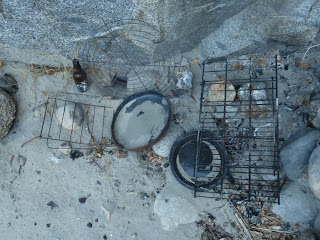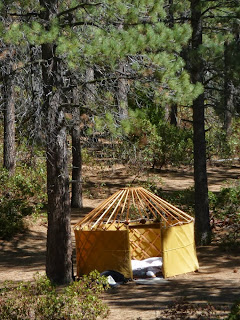Camping is often lauded as a way for harried urbanites to re-connect with nature. Well maybe. Decades ago, I used to go on canoe trips to Quetico Provincial Park in Ontario, Canada, sometimes with friends and sometimes with family. To do these trips, we had to pack all the food we would need for the length of the trip. Not packing enough food would mean going hungry since there are no stores in the park. Then at some point, I took along a fishing rod and caught fish to supplement our meals and surprisingly, my experience of the camping trips changed.
The best way I could describe the new relationship was that it no longer felt like space travel where you had to bring absolutely everything with you that you needed to survive. Once I was able to catch fish, my environment took care of some of my needs. I was not entirely reliant on my environment to provide me with food, but I was not entirely reliant on what I had brought with me either. I felt a new bond with my surroundings. My surroundings now provided for me. My presence in the wood and lake country was in a sense approved of by my environment. I could say that I now filled an ecological niche, that of a fish eater. I was no longer simply a tourist on a life line that led back to the civilized eco-niche that I had come from.
Yes, I was by no means living off the land simply because I caught a few fish, but the fact that the land I traveled through provided me with at least a part of my sustenance changed my relationship with it.
 |
| Camping in Kings Canyon, NP. The yurt dwarfed by tall pines and the canyon wall. |
Fast forward to the recent past. My wife and I spent a few weeks camping in the Sierra Nevada mountains of California. We started out at Kings Canyon National Park but were kicked out because of the government shutdown. After expulsion, we moved on to the Sequoia National Forest where they allow dispersed camping, that is, camping somewhere other than at a designated National Forest campground. We were now entirely on our own for amenities since the NFS wasn't providing any. That is, other than a spot to park your car and pitch your tent, the forest service wasn't providing anything, no toilets, no water, no garbage cans, no bear boxes, no pavement, no wood. Worse yet, because of a prolonged drought, we could not build fires either. We had to stick with our propane fired camp stove. We were able to manage without toilets and had enough drinking water to get us through a few days at a time before needing to replenish. But in a way, we were back in space travel mode. Absolutely everything we needed to survive had to come out of our space module, the family car.
 |
| The yurt after our relocation to Sequoia National Forest. |
Not that camping in a National Park was any better. If anything, under normal conditions, it was even more restrictive and artificial an experience than camping in a national forest. In a national park, you are not supposed to interact with the environment in any way. You can't burn the wood, you can't pick the plants. You can't hunt the animals, nor feed them, though apparently, you can do some fishing where there are fish. Mind you, I am not criticizing National Park policy. I am simply stating the effect it has on the experience of being there which is that it is not meant to be an environment that will support human life. It is an environment that tries very hard to minimize human impact. Any self sustaining activity other than fishing is in effect prohibited. To return to the space travel metaphor, I don't know whether Star Trek with its prohibition of modifying alien cultures came up with this idea on its own or got it from the National Park Service, but there we were, camping without modifying the environment. For the most part, it's great to be in a national park because they manage to preserve the landscape in a state that resembles the state it was in before Europeans showed up. That is, besides some of the most stunning scenery, you also get to see what trees looked like before people cut them all the big ones down. And unlike the national forest, nobody is using the national parks as cow pasture.
So far I haven't even mentioned backpacking. Backpacking gets even closer to space travel than car camping. For backpacking, at least the way it's done these days, you need all sorts of specialized gear that you can only get in a high end camping store. Everything needs to be light weight, including your food which resembles the food of astronauts.
But you can still have some sort of camping experience that doesn't resemble space travel if you are willing to be creative and accept the fact that you can't have humans invading an environment without having some impact on it.
































